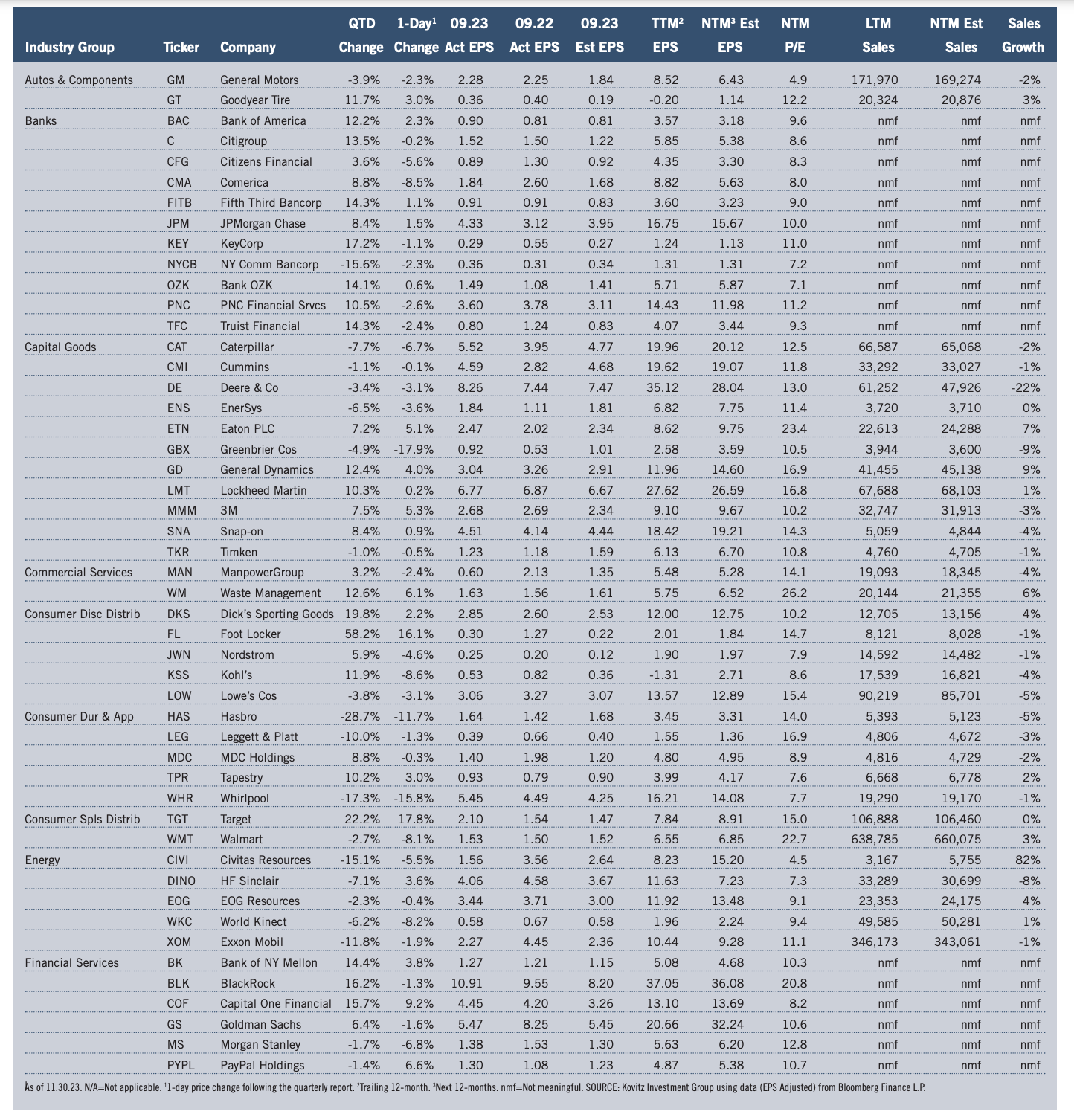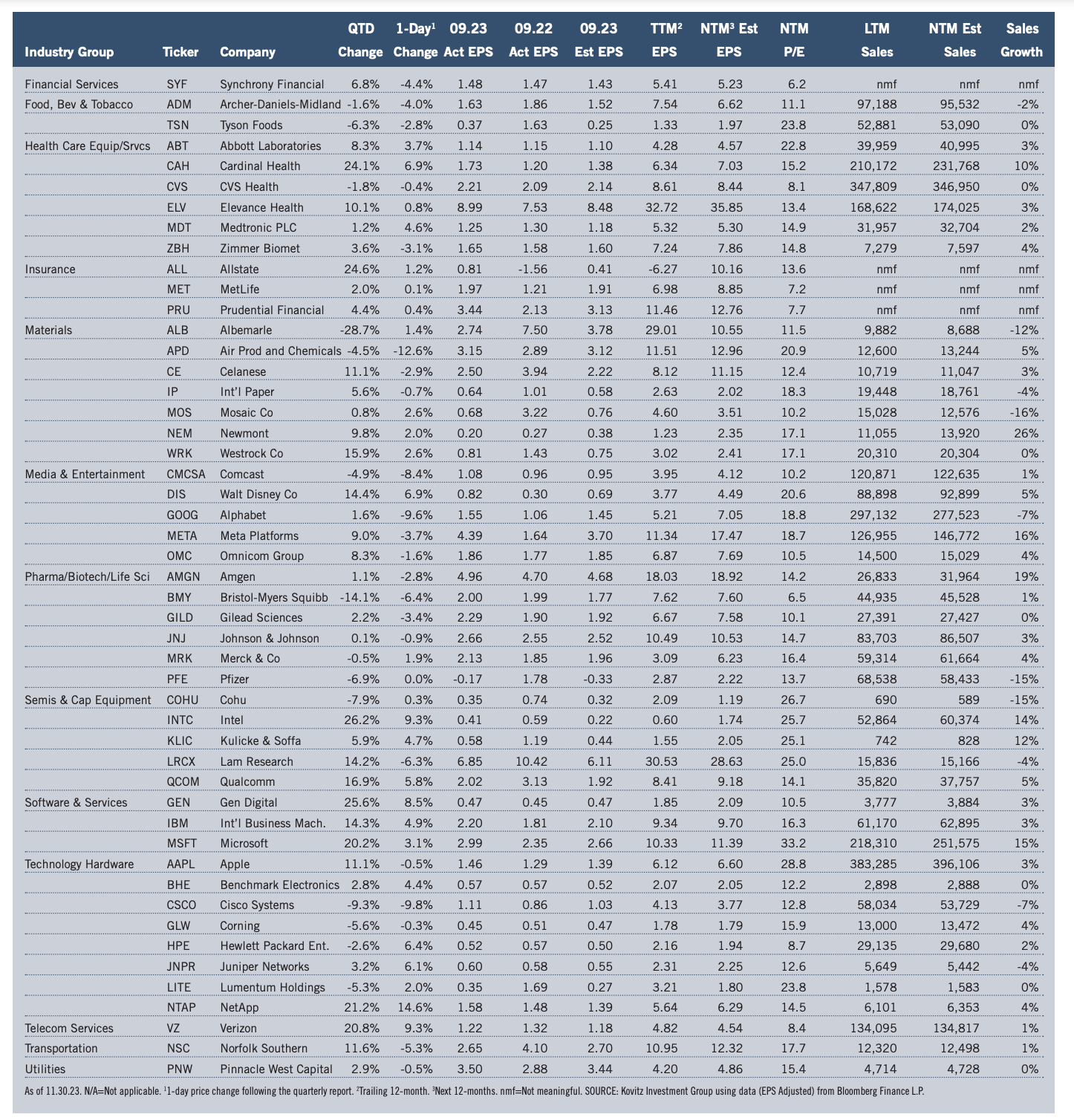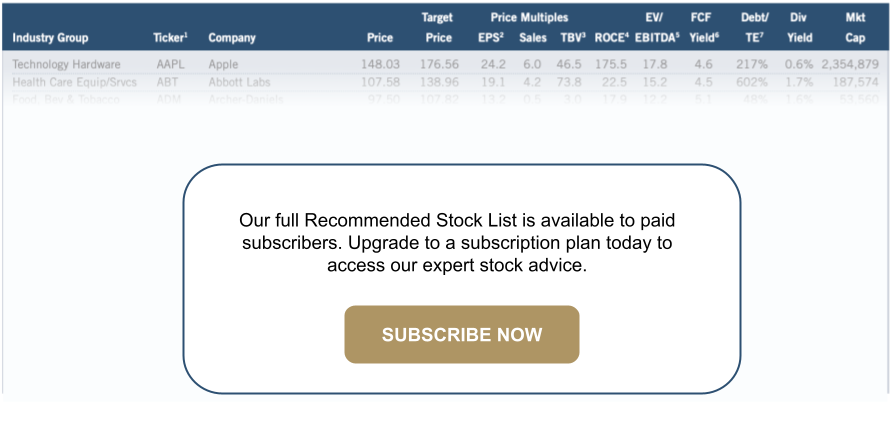
Every month, The Prudent Speculator produces a newsletter that includes a market summary, helpful charts and graphs, recent equity market news, economic outlook and specific stock investment strategies focused on value stock investing. In this month’s newsletter our Graphic Detail feature takes a look at Q3 corporate earnings while we offer three brand-new undervalued stock recommendations. We also include a preview of our current Recommended Stock List and Portfolio Builder section with ten highlighted stocks. Note that the entire list is available to our community of loyal subscribers only.
Editor’s Note: Seasonally Favoritism, Q3 Earnings, Value Stocks and Charlie Munger
We suppose it is fitting that equities would salute legendary investor Charlie Munger’s passing with one of the best months in history. Indeed, stocks of all sizes enjoyed a stellar start to the seasonally more favorable six months of the year, with November seeing returns in the 9% range for both the Russell 2000 (Small-Cap) and the Russell 1000 (Large-Cap) indexes, while the rally was broad-based with the average stock in the Russell 3000 (Small and Large) index posting a 9.1% total return.
Of course, the Berkshire Hathaway Vice Chair would likely have shrugged his shoulders at the big advance last month. In his 99 years, Mr. Munger learned to maintain an even keel, not becoming euphoric about a month like November nor depressed about the dismal three months prior. After all, he proclaimed in 2005, “A lot of people with high IQs are terrible investors because they’ve got terrible temperaments. And that is why we say that having a certain kind of temperament is more important than brains. You need to keep raw irrational emotion under control. You need patience and discipline and an ability to take losses and adversity without going crazy. You need an ability to not be driven crazy by extreme success.”
Obviously, given the average Russell 3000 constituent has returned just 2.4% in 2023, after posting losses in 2022, there has been quite a bit of adversity and little in the way of extreme success the last two years…which we would argue bodes well for the months and years ahead. This is especially true considering Value Stocks historically have turned in average gains of 13.7% per annum since the launch of The Prudent Speculator in 1977, while the Russell 3000 Value index (R3KV), unlike its Russell 3000 Growth counterpart, today trades near its historical mean on both a price-to-book value and price-to-sales basis. More importantly, despite the recent rally, the current earnings yield (inverse of the P/E ratio) for the R3KV of 6.01% is above the 28-year average of 5.80%, not to mention the latest 4.33% yield on the benchmark 10-Year U.S. Treasury, while the present dividend yield of 2.42% exceeds the 2.38% long-term norm.
True, many are concerned about the valuations of the major market averages, whose returns has been fueled by a handful of mega-cap stocks, but Value is about as attractive today relative to Growth as at any time since the bursting of the Tech Bubble back at the turn of the Millennium.
That is not to say that the reports out of Gaza/Israel/Ukraine and other geopolitical headlines are not worrisome, while we realize that there is plenty of uncertainty about Federal Reserve policy, the economy and the strength of corporate profits.
Still, we know equities have overcome dozens of disconcerting events through the years, while the Fed’s preferred measure of inflation, the core personal consumption expenditures index, rising 3.5% in October on a year-over-year basis, down from a 3.7% increase in September, suggests Jerome H. Powell & Co. are likely to “proceed carefully” in terms of future interest rates hikes. In fact, the futures market is suggesting that the Fed Funds rate will be cut by 100+ basis points in 2024 from the current 5.25% to 5.50% range, and long-term interest rates have dropped precipitously.
Turning to the economy, recent figures on housing were weaker than expected and Bloomberg calculates a 50% chance of recession in the next 12 months, but Q3 real GDP growth was just revised upward to 5.2%, while the Atlanta Fed is now projecting Q4 growth of 1.2%, the labor market remains robust, with generation-low jobless claims, and the latest read on consumer confidence ticked higher. And, as we discuss in this month’s Graphic Detail, the outlook for corporate profit growth remains upbeat.
To be sure, anything can happen as we move forward, but we retain our long-term optimism, especially as November validated a favorite Munger quote: “The first rule of compounding is to never interrupt it unnecessarily.”
Graphic Detail: Earnings Scorecard
Q3 Season
Economic numbers in the period generally exceeded expectations and real (inflation-adjusted) U.S. GDP growth came in at a robust 5.2% in Q3, supporting solid revenue and net income numbers from Corporate America, even as management teams engaged in their usual tempering of guidance. Impressively, the number of S&P 500 companies that exceeded bottom-line forecasts was 81.6%, well above the usual “beat” rate, but 49.5% eclipsed top-line projections. Of The Prudent Speculator’s 98 stocks below, 82% topped EPS expectations, though the average one-day price reaction was a loss of 0.2%, yet the average two-month gain since 09.30.23 was 5.0%.
Standard & Poor’s projects (as of 11.30.23) that after dipping from $208.21 in 2021 to $196.95 in 2022 (last year’s figure includes a massive $66.9 billion ($4.74 per share) “unrealized investment” loss from Berkshire Hathaway in Q2), bottom-up operating EPS for the S&P 500 will rise to $214.34 in 2023, with $243.34 the guess for 2024. Estimates are subject to change (current forecasts are a lower than those three months ago) and many still believe a recession is imminent, but anything close to the ‘23 and ‘24 tallies should support much higher stock prices.


Recommended Stock List
In this space, we list all of the stocks we own across our multi-cap-value managed account strategies and in our four newsletter portfolios. See the last page for pertinent information on our flagship TPS strategy, which has been in existence since the launch of The Prudent Speculator in March 1977.
Readers are likely aware that TPS has long been monitored by The Hulbert Financial Digest (“Hulbert”). As industry watchdog Mark Hulbert states, “Hulbert was founded in 1980 with the goal of tracking investment advisory newsletters. Ever since it has been the premiere source of objective and independent performance ratings for the industry.” For info on the newsletters tracked by Hulbert, visit: http://hulbertratings.com/since-inception/.
Keeping in mind that all stocks are rated as “Buys” until such time as we issue an official Sales Alert, we believe that all of the companies in the tables on these pages trade for significant discounts to our determination of long-term fair value and/or offer favorable risk/reward profiles. Note that, while we always seek substantial capital gains, we require lower appreciation potential for stocks that we deem to have more stable earnings streams, more diversified businesses and stronger balance sheets. The natural corollary is that riskier companies must offer far greater upside to warrant a recommendation. Further, as total return is how performance is ultimately judged, we explicitly factor dividend payments into our analytical work.
While we always like to state that we like all of our children equally, meaning that we would be fine in purchasing any of the 100+ stocks, we remind subscribers that we very much advocate broad portfolio diversification with TPS Portfolio holding more than eighty of these companies. Of course, we respect that some folks may prefer a more concentrated portfolio, however our minimum comfort level in terms of number of overall holdings in a broadly diversified portfolio is at least thirty!
TPS rankings and performance are derived from hypothetical transactions “entered” by Hulbert based on recommendations provided within TPS, and according to Hulbert’s own procedures, irrespective of specific prices shown within TPS, where applicable. Such performance does not reflect the actual experience of any TPS subscriber. Hulbert applies a hypothetical commission to all “transactions” based on an average rate that is charged by the largest discount brokers in the U.S., and which rate is solely determined by Hulbert. Hulbert’s performance calculations do not incorporate the effects of taxes, fees, or other expenses. TPS pays an annual fee to be monitored and ranked by Hulbert. With respect to “since inception” performance, Hulbert has compared TPS to 19 other newsletters across 62 strategies (as of the date of this publication). Past performance is not an indication of future results. For additional information about Hulbert’s methodology, visit: http://hulbertratings.com/methodology/.
Portfolio Builder
Each month in this column, we highlight 10 stocks with which readers might populate their portfolios: Fresh Del Monte (FDP), KeyCorp (KEY), Regency Centers (REG) and seven others.








